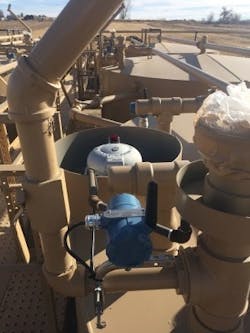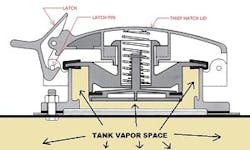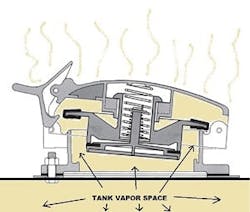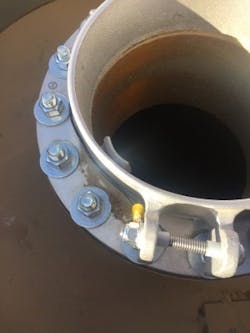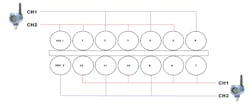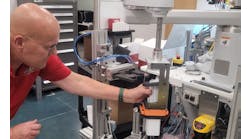Figure 1: Thief hatches on the tops of tanks of Great Western Oil & Gas Co. in Colorado allow access to the tank and protect the tank from overpressure. If left open, huge fines can result.
Thief hatches (Figure 1) are installed on the top of low-pressure and atmospheric tanks in the oil & gas, chemical, pharmaceutical, biogas, water treatment and other industries to allow access to the tank. They can be used to take samples of the tank’s contents and determine the level of the tank, and they protect the tank from overpressure and excessive vacuum.
The thief hatch acts as a pressure safety device on the tank. When closed and latched, two separate, spring-loaded seals protect against excessive pressure or vacuum. If excessive pressure builds up in the tank, the hinged hatch cover will break its seal, lift and allow the pressure to escape to the atmosphere. When the pressure or vacuum is reduced to the setpoint, the seal is reseated by either spring, sealing the tank.
When a thief hatch closes—either from gravity or from a worker closing it—the hatch may not seal unless it is firmly latched. This allows vapors in the tank to leak into the atmosphere, which can violate regulations.
To avoid stiff penalties and protect the environment, Great Western Oil and Gas Company installed wireless thief hatch monitoring systems on its oil tanks in the Denver-Julesburg (DJ) Basin in Colorado. The DJ Basin is a 70,000-square-mile area in northeast Colorado, southeast Wyoming and southwest Nebraska. More than 52,000 wells have been drilled in the DJ Basin. Great Western has more than 600 operating wells there, producing nearly 13,800 barrels of oil per day.
Great Western Oil & Gas Company is a Top-10 driller in Colorado, among the Top 100 drillers in the U.S., and makes every effort to meet all environmental regulations—especially in Colorado, where penalties for non-compliance are severe.
Tough regulations
The State of Colorado has some of the oil industry’s toughest environmental regulations. The Colorado Department of Public Health and Environment requires monitoring of thief hatches on oil and water tanks to prevent release of methane and volatile organic compounds (VOCs) to the atmosphere. The regulation, XII.E.4.d reads, “For all atmospheric condensate storage tanks, the owner or operator shall check for and document on a weekly basis that the thief hatch is closed and latched.”
Figure 2: A thief hatch has a lid that can be manually opened. The latch (upper left) keeps the lid closed and the tank sealed.
To enforce the regulation, Colorado inspectors regularly check for emissions from leaks and open thief hatches with thermal scopes and infrared cameras. The state inspectors document any open thief hatches, and compare their records to the producer’s by time and location. If the producer can confirm the thief hatch was open—perhaps for maintenance or sampling—at the same time as the inspector found it open, then there’s no problem and no penalty. If the producer cannot confirm from its records as to why the hatch was open, penalties and fines are assessed. Penalties are severe, with fines up to $15,000 per day per open thief hatch, with many facilities having scores of thief hatches per site.
Oil producers nationwide fear the U.S. EPA will soon adopt a similar regulation, and are searching for ways to monitor their thief hatches in a cost-effective manner.
Inside a thief hatch
Figure 3: An unlatched thief hatch allows volatile gases to escape, and if detected by the State of Colorado, fines of up to $15,000 per day, per open hatch can be incurred.
A thief hatch is a rugged device designed for harsh environments and handling by “less than gentle” users. Made from cast aluminum, thief hatches are used on fiberglass and steel tanks in the oil & gas, chemical, pharmaceutical, biogas, water treatment and other industries. Most tanks used in these heavy industry applications come with a thief hatch (Figure 2).
The thief hatch has a latch that locks the lid closed. If an operator opens the hatch to check tank level or take a sample, he or she lifts the latch, raises the lid, performs the necessary function, and closes and latches the hatch. If the lid is not properly latched, the tank will not be sealed and will vent to atmosphere. (Figure 3) This is what Colorado wants to eliminate from production facilities: the unnecessary release of methane and VOCs into the atmosphere.
Monitoring thief hatches
R3 Automation, an automation services company in Windsor, Colorado, has been working with Emerson Process Automation and several upstream oil & gas companies to develop a thief hatch monitoring system. Rosemount 702 discrete WirelessHART transmitters (Figure 4) can be installed on existing thief hatches and tank batteries to effectively ensure the hatches are closed and latched.
Figure 4: This thief hatch at Great Western Oil & Gas is fitted with a WirelessHART monitoring system developed by R3 Automation. When the latch is not closed, the wireless transmitter sends a signal to the facility's controller so that it can be logged or an alert can be sent out.
The concept is fairly simple: A switch at the latch (Figure 5) detects when the latch is closed. The switch is non-powered, has no magnets, is easy to install on new or existing thief hatches, and no hot work is required. The switch is wired to an intrinsically-safe, wireless transmitter. The battery-powered transmitter is also easy to install. It requires no power wiring and no signal wiring, so it can be mounted in any convenient location on top of the tank. To conserve battery life, the scan rate is once per minute—more than sufficient for this monitoring application.
The estimated cost for installing a WirelessHART thief hatch monitoring system on one tank battery (8 tanks) was calculated to be about $8,300, including switches, wire, terminations, transmitters and labor.
The per tank cost can be substantially reduced if latches on a tank battery are wired in series to a single transmitter. This type of installation will indicate if one of the hatches in the bank is open, but not which one. In practice, an operator would be sent to site to determine which one needs to be fully closed and latched. This method of monitoring complies with regulations, is the most practical, and it allows very quick response to any open hatch conditions.
Figure 5: A simple switch (yellow) detects if the latch is opened or closed. The switch is non-powered, has no magnets, is easy to install on new or existing thief hatches, and not hot work is required.
If a tank farm doesn’t already have a WirelessHART infrastructure, the cost of a WirelessHART gateway must be added. To date, R3 Automation has installed WirelessHART thief hatch monitoring systems on more than 100 tanks at five different oil producers in the DJ Basin.
Working wirelessly
At Great Western’s tank farm near Brighton, Colorado, WirelessHART thief tank monitors were installed on two water and 12 oil tanks. The tank monitoring system is arranged in banks as shown in Figure 6. At the top of the figure, oil tanks 2, 4 and 6 are wired in series to channel 1 of the WirelessHART transmitter. Water (H2O) tank 1 and oil tanks 1, 3 and 5 are wired in series to channel 2 of the WirelessHART transmitter.
At the bottom of the figure, oil tanks 7, 8, 10 and 12 are wired in series to channel 1 of the WirelessHART transmitter. Water tank 2 and oil tanks 9 and 11 are wired in series to channel 2 of the transmitter. The wireless transmitters send their data to a gateway mounted on a DIN rail in the production facility’s main control room.
In addition to the thief hatch monitors, the tank farm has 30 more Rosemount WirelessHART level switches, temperature transmitters and pressure transmitters mounted on the tanks to create a comprehensive tank monitoring system. The data from all transmitters goes to the WirelessHART gateway, which is hardwired to a TotalFlow RTU. The system is programmed to monitor the thief hatch signals and report any open hatches to the operators.
Because the tanks are wired in four banks, operators can narrow down an open hatch condition to, at most, four tanks, making it quick and easy for field technicians to locate the offending hatch and latch it closed.
Figure 6: Great Western's tank farm has WirelessHART thief hatch monitors on two water and 12 oil tanks. At the top, oil tanks 2, 4 and 6 are wired in series to channel 1 of the WirelessHART transmitter. Water (H2O) tank 1 and oil tanks 1, 3 and 5 are wired in series to channel 2 of the WirelessHART transmitter.
No more fines
The monitoring system alerts operators to open hatch conditions within one minute, allowing quick resolution of any problems. Field technicians no longer need to periodically monitor and document the status of thief hatches manually, but instead only need to respond to an open hatch alert. This reduces manpower requirements for monitoring thief hatches, and demonstrates Great Western is employing the best available technology to protect the environment and comply with regulations. Great Western is not only reducing emissions for the benefit of its neighboring communities, it’s containing gases that can be recovered and sold.
In addition to the 14 tanks in Brighton, Colorado, R3 Automation has installed WirelessHART thief hatch monitors at two other Great Western tank farms. To date, none of those thief hatches have been detected open by the State of Colorado because the facility can now react very quickly to any open hatch conditions.
Although Colorado is the only state so far to issue tough regulations for monitoring thief hatches, such regulations are probably coming from the U.S. EPA or from individual states. WirelessHART thief hatch monitoring is a cost-effective solution to avoid fines, reduce product loss to the atmosphere and cut emissions.
Vance Ray, founder, R3 Automation, has 10 years of oil and gas automation experience in the DJ Basin, starting as an automation installer for Winn-Marion and learning the necessary programing required to install oil & gas automation software. Working his way to Supervisor, he has served with Anadarko, Noble, Extraction, Great Western and DCP Midstream. In 2015, Ray started R3, which has grown from a four to 36 employees. He can be reached at [email protected].
Latest from Asset Management

Leaders relevant to this article:

